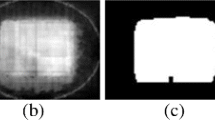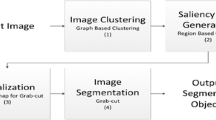Abstract
Salient object detection from an image is important for many multimedia applications. Existing methods provide good solutions to saliency detection; however, their results often emphasize the high-contrast edges, instead of regions/objects. In this paper, we present a method for salient object detection based on oscillation analysis. Our study shows that salient objects and their backgrounds have different amplitudes of oscillation between the local minima and maxima. Based on this observation, our method analyzes the oscillation in an image by estimating its local minima and maxima and computes the saliency map according to the oscillation magnitude contrast. Our method detects the local minima and maxima and performs extreme interpolation to smoothly propagate these information to the whole image. In this way, the oscillation information is smoothly assigned to regions, retaining well-defined salient boundaries as there are large variations near the salient boundaries (edges between objects and their backgrounds). As a result, our saliency map highlights salient regions/objects instead of high-contrast boundaries. We experiment with our method on two large public data set. Our results demonstrate the effectiveness of our method. We further apply our salient object detection method to automatic salient object segmentation, which again shows the success.
















Similar content being viewed by others
References
Achanta R, Estrada F, Wils P, Susstrunk S (2008) Salient region detection and segmentation. In: International conference on computer vision systems
Achanta R, Hemamiz S, Estraday F, Susstrunk S (2009) Frequency-tuned salient region detection. In: IEEE international conference on computer vision and pattern recognition
Achanta R, Susstrunk S (2010) Saliency detection using maximum symmetric surround. In: International conference on image processing
Cheng M, Zhang G, Mitra NJ, Huang X, Hu S (2011) Global contrast based salient region detection. In: IEEE conference on computer vision and pattern recognition, pp 409–416
Christopoulos C, Skodras A, Koike A, Ebrahimi T (2000) The jpeg2000 still image coding system: an overview. IEEE Trans Consum Electron 46(4):1103–1127
Duan L, Wu C, Miao J, Qing L, Fu Y (2011) Visual saliency detection by spatially weighted dissimilarity. In: IEEE conference on computer vision and pattern recognition, pp 473–480
Fu Y, Cheng J, Li Z, Lu H (2008) Saliency cuts: an automatic approach to object segmentation. In: Proc. ICPR2008, pp 1–4
Gijsenij A, Gevers T (2011) Color constancy using natural image statistics and scene semantics. IEEE Trans Pattern Anal Mach Intell 33(4):687–698
Goferman S, Zelnik-Manor L, Tal A (2010) Context-aware saliency detection. In: IEEE conference on computer vision and pattern recognition, pp 2376–2383
Gopalakrishnan V, Hu Y, Rajan D (2009) Random walks on graphs to model saliency in images. In: IEEE conference on computer vision and pattern recognition
Han J, Ngan K, Li M, Zhang H (2006) Unsupervised extraction of visual attention objects in color images. IEEE Trans Circuits Syst Video Technol 16(1):141–145
Harel J, Koch C, Perona P (2007) Graph-based visual saliency. Adv Neural Inf Process Syst 19:545–552
Hou X, Zhang L (2007) Saliency detection: a spectral residual approach. In: IEEE conference on computer vision and pattern recognition
Hu Y, Rajan D, Chia LT (2005) Robust subspace analysis for detecting visual attention regions in images. In: ACM international conference on multimedia
Itti L, Koch C, Niebur E (1998) A model of saliency-based visual attention for rapid scene analysis. IEEE Trans Pattern Anal Mach Intell 20(11):1254–1259
Ko BC, Nam JY (2006) Object-of-interest image segmentation based on human attention and semantic region clustering. J Opt Soc Am A 23(10):2462–2470
Levin A, Lischinski D, Weiss Y (2004) Colorization using optimization. ACM Trans Graph 23(3):689–694
Liu H, Xie X, Ma WY, Zhang HJ (2003) Automatic browsing of large pictures on mobile devices. In: Proceedings of the ACM international conference on multimedia, pp 148–155
Liu T, Sun J, Zheng NN, Tang X, Shum HY (2007) Learning to detect a salient object. In: IEEE conference on computer vision and pattern recognition
Ma YF, Zhang HJ (2003) Contrast-based image attention analysis by using fuzzy growing. In: ACM international conference on multimedia
Otsu N (1979) A threshold selection method from gray-level histograms. IEEE Trans Syst Man Cybern 9:62–66
Rother C, Kolmogorov V, Blake A (2004) “grabcut”: interactive foreground extraction using iterated graph cuts. ACM Trans Graph 23:309–314
Rubinstein M, Gutierrez D, Sorkine O, Shamir A (2010) A comparative study of image retargeting. ACM Trans Graph 29(5):160:1–160:10
Setlur V, Takagi S, Raskar R, Gleicher M, Gooch B (2005) Automatic image retargeting. In: Proceedings of the 4th international conference on mobile and ubiquitous multimedia (MUM 2005), pp 59–68
Subr K, Soler C, Durand F (2009) Edge-preserving multiscale image decomposition based on local extrema. ACM Trans Graph 28(5):147:1–147:9
Suh B, Ling H, Bederson BB, Jacobs DW (2003) Automatic thumbnail cropping and its effectiveness. In: Proceedings of ACM UIST, pp 95–104
Wang Z, Li B (2008) A two-stage approach to saliency detection in images. In: International conference on acoustics, speech and signal processing
Yanulevskaya V, Geusebroek JM (2009) Significance of the weibull distribution and its sub-models in natural image statistics. In: International conference on computer vision theory and applications, pp 355–362
Zhai Y, Shah M (2006) Visual attention detection in video sequences using spatiotemporal cues. In: Proceedings of the 14th annual ACM international conference on Multimedia, pp 815–824
Acknowledgements
We would like to thank the reviewers for their insightful and constructive comments. This research is supported by Shandong Provincial Natural Science Foundation of China (Grant No. ZR2011FM037) and Innovation Fund for Distinguished Graduate Student of Shandong University (Grant No. yyx10043).
Author information
Authors and Affiliations
Corresponding author
Rights and permissions
About this article
Cite this article
Liu, Y., Li, X., Wang, L. et al. Oscillation analysis for salient object detection. Multimed Tools Appl 68, 659–679 (2014). https://doi.org/10.1007/s11042-012-1072-6
Published:
Issue Date:
DOI: https://doi.org/10.1007/s11042-012-1072-6




